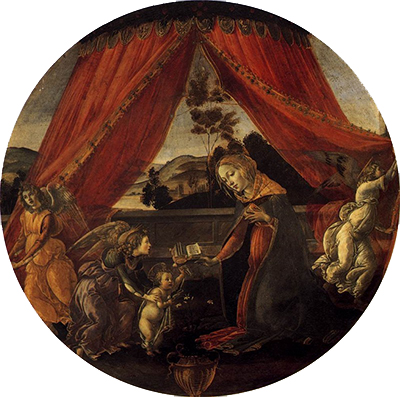The Madonna and Child with Three Angels (Madonna del Padiglione) was completed by Sandro Botticelli in 1493 and is now on display at the Pinacoteca Ambrosiana, Milan
This relatively dark artwork features a combination of Botticelli's stunning figurative work and also flowing drapery in the background which is being held open by angels. Within the foreground the Virgin holds a book to her chest and interacts with a young child. As with many of Botticelli's paintings, you will find children here being supported by angels.
This tempera on panel has a diameter of 65 cm and circular paintings such as this are historically referred to as tondos in Italian. See, for example, Doni Tondo by Michelangelo. This artwork is also sometimes known as Madonna of the Tent or Ambrosiana Tondo, in honour of its owner.
The Pinacoteca Ambrosiana in Milan has a long history of owning and displaying world famous art, predominantly from the Renaissance. The collection currently residing at the gallery is almost a who's who of the Italian and Northern Renaissance. The Musician by Leonardo da Vinci, The Basket of Fruit by Caravaggio, a cartoon study for Raphael's School of Athens and Titian's Adoration of the Magi spearhead this fine selection of artwork.
Madonna del Padiglione, a tempera on panel by Sandro Botticelli, sits alongside a contribution from the Northern Renaissance in Jan Brueghel's Vases of Flowers (Pieter Bruegel the Elder was the best known from this famous artistic family).
The use of Padiglione is this particular naming of the painting refers to the pavilion that appears in the background of the artwork. The symbolism in this artwork is predominantly the combinaton of books and drapery which represent that a prophecy has occurred, namely the borth of Christ.
The purpose of the angel in the foreground is to deliver Christ to his mother. Technically speaking, Mary is clearly too large in relation to everything else in the composition but this is a deliberate act by Botticelli in order to draw maximum attention to her.




